Overcoming Common Challenges
Setting up span anchors in rope rescue operations requires precision, planning, and adaptability. These systems play a crucial role in creating tensioned highlines or transporting loads across challenging environments. However, their setup presents unique challenges that demand expertise in tension management, anchor strength, force vector analysis, and adaptability to environmental conditions. Below, we explore these challenges in detail and discuss strategies for overcoming them effectively.
Tension Management in Span Anchor Systems
Tension management is one of the most critical and complex aspects of span anchor systems. Proper tension ensures system stability, minimizes sag, and maintains operational efficiency. However, achieving the right balance can be a challenge.
Risks of Over Tensioning
While maintaining tension is necessary, over tensioning introduces significant risks:
- Excessive Stress on Anchors: Forces beyond the safe working load can compromise anchor integrity, leading to failure.
- Damage to Ropes and Equipment: Overloading ropes increases friction, heat buildup, and wear, reducing rope lifespan.
- Dynamic Failure: In the event of sudden loads or shock loading, over tensioned systems are prone to catastrophic failure.
Issues with Under Tensioning
On the other hand, insufficient tension can create equally dangerous problems:
- Sagging Systems: Excessive sag in the highline reduces efficiency and prevents the load from maintaining clearances over obstacles.
- Terrain Contact: Sagging lines may allow loads to hit obstacles or terrain, putting personnel and equipment at risk.
- Reduced Control: Poorly tensioned systems lose their ability to maintain smooth, stable movement of personnel or gear.
Solution: Use properly calibrated mechanical advantage (MA) systems to achieve controlled tensioning. Progress capture devices, such as the Petzl I’D or prusik loops, allow teams to add or release tension safely and incrementally.
Selecting Suitable Anchors
Anchor points serve as the foundation of any span anchor system. Finding reliable and appropriately strong anchor points can be difficult, particularly in varied environments like urban or wilderness settings.
Key Considerations for Anchor Selection:
- Load Capacity: Anchors must withstand the maximum anticipated load, including any dynamic forces caused by movement, shifting, or environmental factors.
- Environmental Factors: Natural anchors (trees, rock formations) or artificial anchors (structures, vehicles) must be assessed for stability, strength, and accessibility.
- Redundancy: Always establish redundant anchor systems to ensure safety, especially in challenging or limited environments. When a single anchor fails, redundancy prevents system collapse.
Practical Tip: In environments where natural anchors are insufficient, tools like portable tripods, beam clamps, and deadman anchors provide adaptable solutions. The CMC Arizona Vortex offers versatility for creating elevated anchor points in confined spaces or uneven terrain.
Managing Vector Forces and Angles
The geometry of span anchor systems creates significant vector forces at the anchor points, which can quickly multiply if not managed correctly.
Vector Force Challenges:
- Forces increase dramatically as the angle between the anchor points widens.
- At a 150-degree angle, the force on each anchor is approximately twice the load weight.
- As the angle approaches 175 degrees, forces can reach up to 11 times the weight of the load.
Example: If the rescue load weighs 300 pounds, an improperly tensioned system with high angles could place over 3,000 pounds of force on each anchor, creating a high risk of failure.
Solution: Aim to keep anchor angles under 120 degrees whenever possible to minimize force multiplication. Use force analysis tools, such as the T-method, to calculate anchor loads and adjust system geometry accordingly.
Navigating Rigging Complexity
Setting up a span anchor system involves multiple components, requiring teams to ensure proper integration and rigging safety.
Common Rigging Challenges:
- Mechanical Advantage Systems: Using 3:1 or 5:1 MA systems ensures controlled tensioning without excessive effort. Progress capture devices (like the Petzl Pro Traxion) help lock in tension safely.
- Edge Protection: Ropes running over sharp edges are prone to abrasion and failure. Install edge protection devices like rope pads, rollers, or the CMC Edge Guards to minimize damage.
- Equipment Selection: Choose appropriate pulleys, carabiners, and connectors rated for rescue loads. High-efficiency pulleys reduce friction and system inefficiency.
Adapting to Environmental Challenges
Span anchor systems must adapt to diverse environments, from urban structures to wilderness terrain or water-based rescues.
Urban Settings:
- Anchor points may include buildings, I-beams, or vehicles. Assess structural integrity before use and utilize tools like beam clamps or tensioned slings.
Wilderness Areas:
- Reliable natural anchors (trees, boulders) may be sparse. Portable anchor systems, such as pickets or multi-anchor arrays, provide flexibility.
Water Rescues:
- Swiftwater rescues demand tight tension to avoid sagging lines. Low-stretch static ropes combined with tensioned anchors help maintain clearances above water.
Safety and Risk Management
Safety remains paramount in all span anchor operations. Teams must account for dynamic loads, monitor systems for potential failures, and prioritize rescuer safety at all times.
Critical Safety Considerations:
- Dynamic Loads: Sudden movements, rescuer slips, or shock loading must be accounted for to prevent system failure. Use dynamic directional pulleys to control load movement.
- System Monitoring: Assign team members to monitor the system throughout the operation, checking for rope tension, anchor stability, and equipment wear.
- Personnel Safety: Edge attendants working near unprotected areas must wear proper PPE and remain tethered to secondary lines for fall protection.
Conclusion
Setting up span anchors in rope rescue systems requires balancing tension management, anchor strength, force geometry, and environmental adaptability. By understanding and addressing these challenges, rescue teams can create safer and more efficient systems. Proper rigging, calculated force distribution, and constant system monitoring ensure that span anchor operations succeed under even the most difficult conditions.
For advanced training, equipment solutions, and rigging systems, explore Rigging Lab Academy and Rescue Response Gear for resources designed to support your team’s success.
Peace on your Days
Lance










